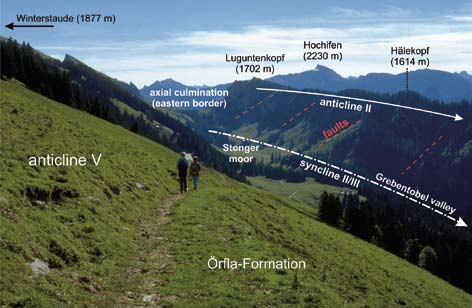Fold and fault control on the drainage pattern of a double-karst-aquifer system, Winterstaude, Austrian Alps
DOI:
https://doi.org/10.3986/ac.v39i2.91Abstract
Lithostratigraphy and geologic structures are major controls on groundwater flow in alpine karst systems. Understanding these factors is important for the delimitation of drinking water protection zones. The Winterstaude mountain chain, western Austria, belongs to the Helvetic nappes and consists of Cretaceous sedimentary rocks, including two karstifiable formations: Örfla and Schrattenkalk Limestone (lower and upper karst aquifer), separated by 60 m of marl. Strata are folded and cut by faults withdisplacements of 40–70 m. Folded carbonate rocks continue below the alluvial valley floor so that the karst system can be subdivided in shallow and deep phreatic zones. This area is suitable for studying the combined influence of folds and faults on groundwater flow in a double-aquifer system. A multi-tracer test withseven injections aimed at characterising hydraulic connections and linear flow velocities. Results show that (i) plunging synclines form the main drainage pathways in the upper karst aquifer, withmaximum linear velocities of 91 m/h, while anticlines act as water divides; (ii) recharge into the lower aquifer, whichforms the central ridge of the mountain chain, contributes to springs discharging from the upper aquifer near the foot of the mountain (local flow systems); (iii) the two aquifers are hydraulically connected, presumably via faults, because their displacements are in the same order of magnitude as the thickness of the intervening marl; (iv) flow in the upper aquifer continues below the valley floor toward the river, withmaximum velocities of 22 m/h(intermediate flow system).
Downloads

Downloads
Published
How to Cite
Issue
Section
License
Authors guarantee that the work is their own original creation and does not infringe any statutory or common-law copyright or any proprietary right of any third party. In case of claims by third parties, authors commit their self to defend the interests of the publisher, and shall cover any potential costs.
More in: Submission chapter




